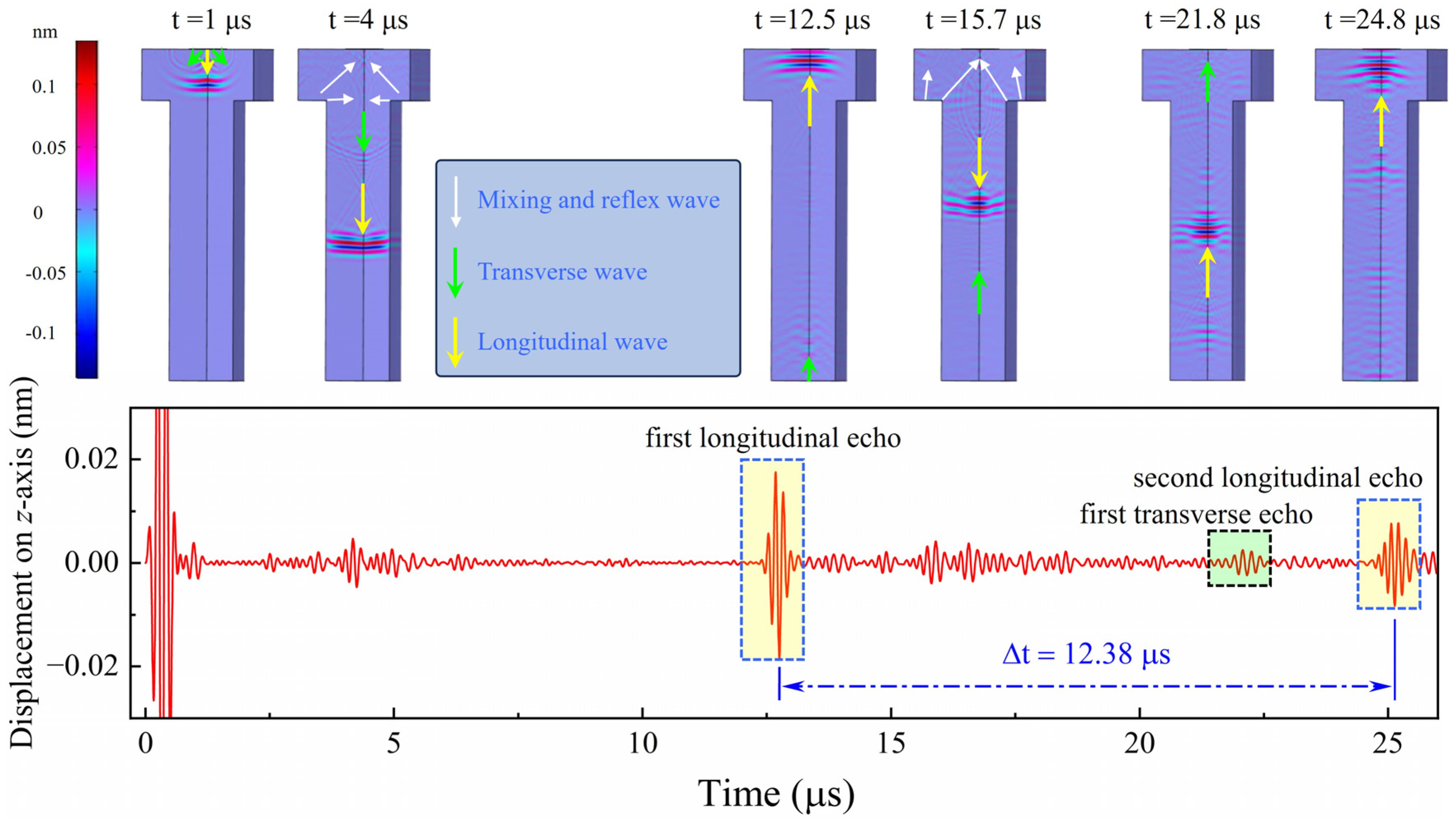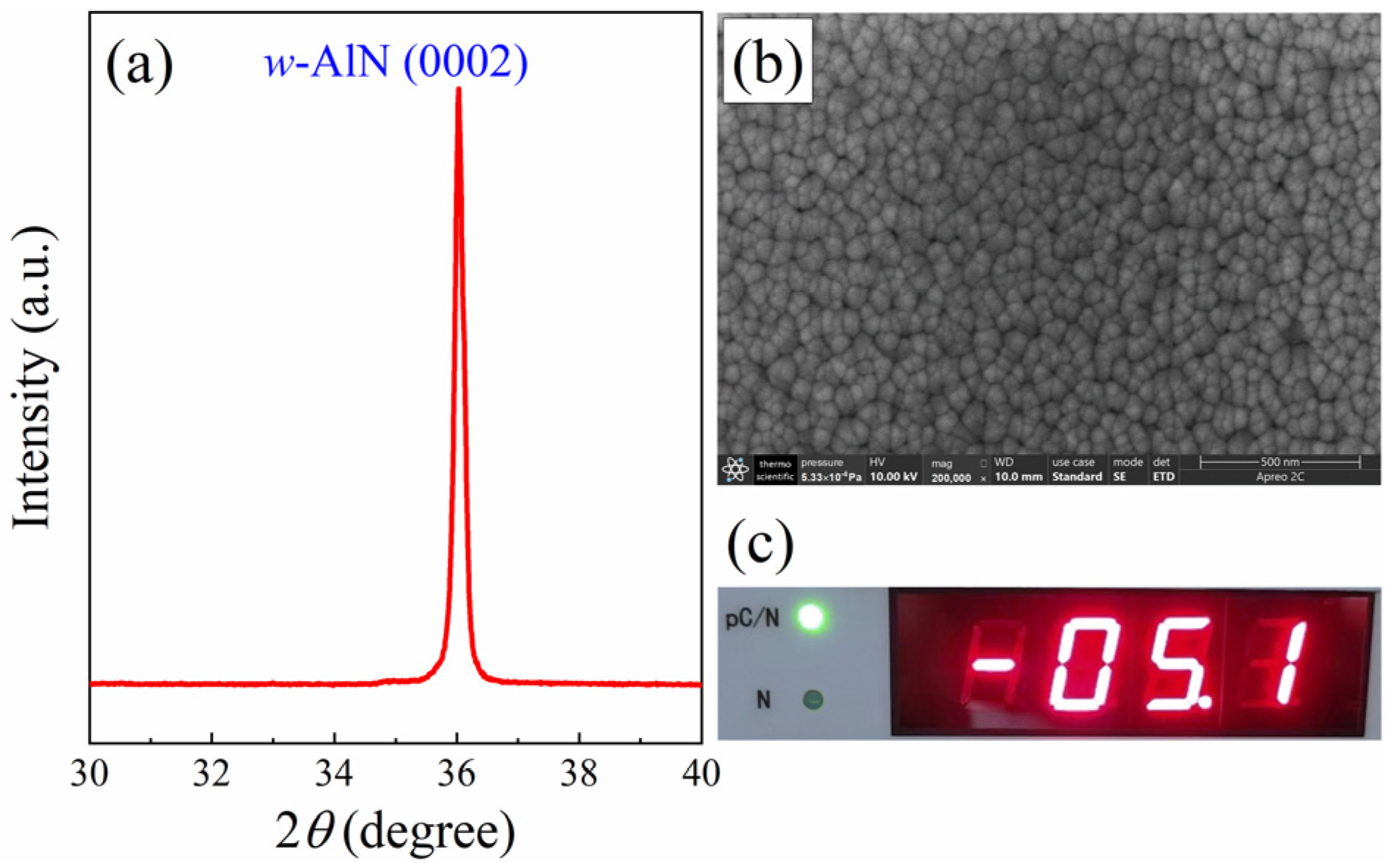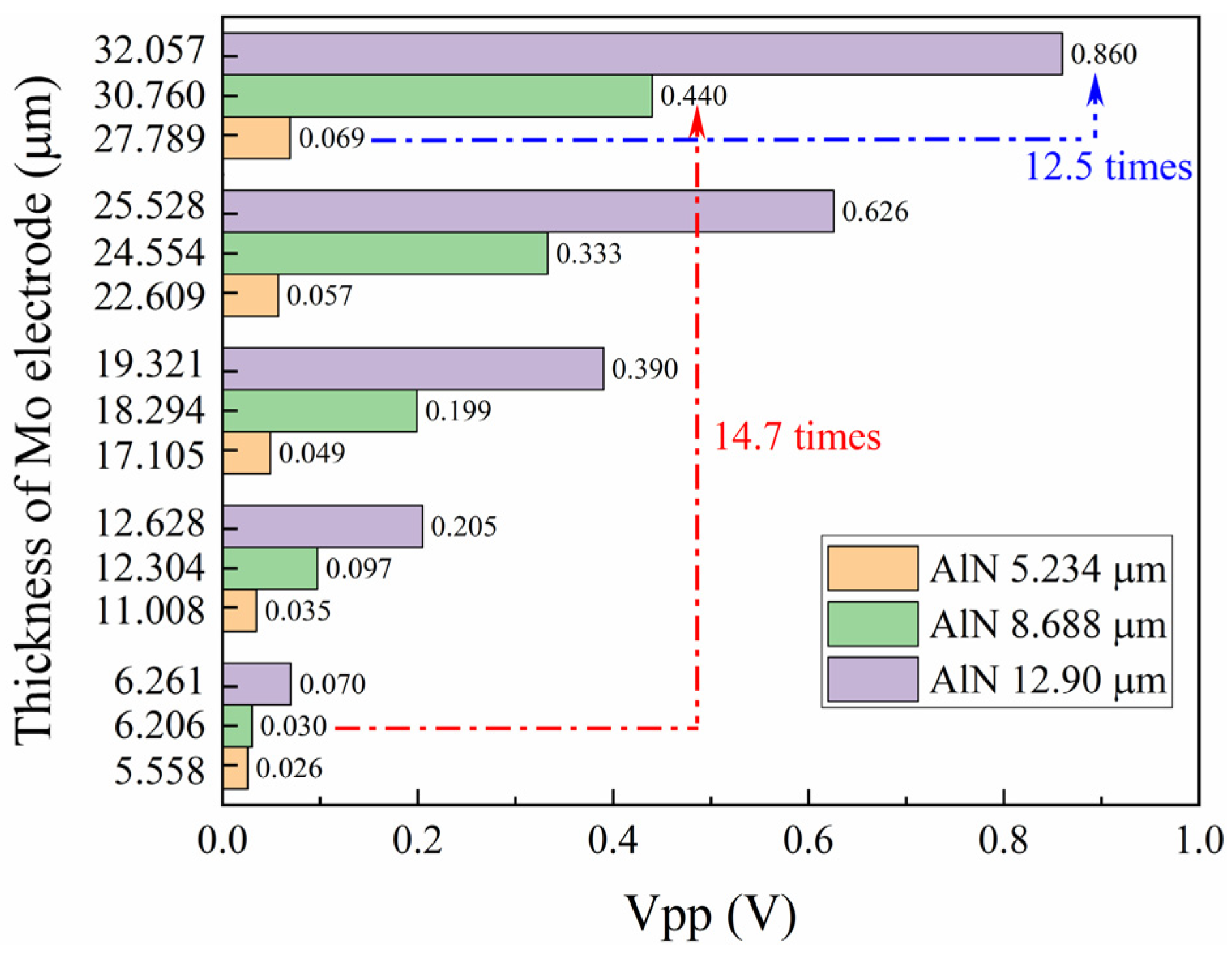Enhancing Ultrasonic Echo Response of AlN Thin Film Transducer Deposited by RF Magnetron Sputtering
Abstract
:1. Introduction
2. Experimental Details
2.1. Transducer Integration
2.2. Theoretical Model
3. Results and Discussion
3.1. Piezoelectric Layer Thickness Design
3.2. Electrode Layer Thickness Design
3.3. Electrode Diameter Design
3.4. Pretightening Stress Measurement
4. Conclusions
Author Contributions
Funding
Institutional Review Board Statement
Informed Consent Statement
Data Availability Statement
Conflicts of Interest
References
- Liu, E.; Liu, Y.; Tan, J. Pretightening Stress Measurement Method of Aero-Engine Fastening Components Based on Acoustic Time Difference Separation of the Coupling Layers. Mech. Syst. Signal Process. 2023, 204, 110811. [Google Scholar] [CrossRef]
- Xiao, J.; Yan, Z.; Shi, J.; Ma, D. Effects of Wheel-Rail Impact on the Fatigue Performance of Fastening Clips in Rail Joint Area of High-Speed Railway. KSCE J. Civ. Eng. 2022, 26, 120–130. [Google Scholar] [CrossRef]
- Glass, S.W.; Thigpen, B.; Renshaw, J. Ultrasound and Nonlinear Resonant Testing of Nuclear Reactor Internals Bolts. In Proceedings of the ASME 2011 Pressure Vessels and Piping Conference, Baltimore, MD, USA, 17–21 July 2011; pp. 185–189. [Google Scholar] [CrossRef]
- Chaki, S.; Corneloup, G.; Lillamand, I.; Walaszek, H. Combination of Longitudinal and Transverse Ultrasonic Waves for In Situ Control of the Tightening of Bolts. J. Press. Vessel. Technol. 2007, 129, 383–390. [Google Scholar] [CrossRef]
- Liu, S.; Sun, Z.; Ren, G.; Liao, C.; He, X.; Luo, K.; Li, R.; Jiang, W.; Zhan, H. Ultrasonic Measurement of Axial Preload in High-Frequency Nickel-Based Superalloy Smart Bolt. Sensors 2023, 23, 220. [Google Scholar] [CrossRef] [PubMed]
- Li, X.; Wang, S.; Li, Z.; Yang, R.; Li, Z. Measurement of Bolt Axial Stress Using a Combination of Trailing Wave and Shear Wave Ultrasound. NDT E Int. 2024, 143, 103056. [Google Scholar] [CrossRef]
- Sun, Q.; Yuan, B.; Mu, X.; Sun, W. Bolt Preload Measurement Based on the Acoustoelastic Effect Using Smart Piezoelectric Bolt. Smart Mater. Struct. 2019, 28, 055005. [Google Scholar] [CrossRef]
- Liu, E.; Liu, Y.; Wang, X.; Ma, H.; Chen, Y.; Sun, C.; Tan, J. Ultrasonic Measurement Method of Bolt Axial Stress Based on Time Difference Compensation of Coupling Layer Thickness Change. IEEE Trans. Instrum. Meas. 2021, 70, 1–12. [Google Scholar] [CrossRef]
- Mills, B.; Javadi, Y.; Abad, F.; Lotfian, S.; MacLeod, C.; Mehmanparast, A.; Pierce, G.; Gachagan, A. Inspection of Wind Turbine Bolted Connections Using the Ultrasonic Phased Array System. Heliyon 2024, 10, e34579. [Google Scholar] [CrossRef]
- Pan, Q.; Pan, R.; Shao, C.; Chang, M.; Xu, X. Research Review of Principles and Methods for Ultrasonic Measurement of Axial Stress in Bolts. Chin. J. Mech. Eng. 2020, 33, 11. [Google Scholar] [CrossRef]
- Zhang, M.; Liu, S.; Zhan, H.; Sun, Z.; Qiu, W.; Ren, G.; Li, R.; Xiang, X.; Wang, H. Fabrication and Characterization of Smart Titanium Alloy Bolt Based on High-Frequency Piezoelectric Thin-Film. Rev. Sci. Instrum. 2024, 95, 035001. [Google Scholar] [CrossRef]
- Zeng, X.; Zhang, X.; Pelenovich, V.; Neena, D.; Xu, C.; Liu, Y.; Jiang, Y.; Zeng, L.; Pogrebnjak, A.; Vildanov, R.; et al. High-Temperature Thin Film Lithium Niobium Oxide Transducers for Bolts. Ceram. Int. 2023, 49, 7710–7716. [Google Scholar] [CrossRef]
- Zeng, X.; Pelenovich, V.O.; Zhang, X.; Xu, C.; Ding, Y.; Wang, Z.; Chen, Z.; Zhang, J.; Yang, B.; Pogrebnjak, A.; et al. Response Optimization of LiNbO3 Ultrasonic Transducers for High Temperature Measurement. IEEE Sens. J. 2024, 24, 7513–7520. [Google Scholar] [CrossRef]
- Zeng, X.; Pelenovich, V.; Xu, C.; Neena, D.; Jiang, Y.; Zhang, X.; Pogrebnjak, A.; Rakhimov, R.; Zhang, J.; Yang, B.; et al. Morphology of Lithium Niobium Oxide Thin Film Ultrasonic Transducers Deposited by RF Magnetron Sputtering. Ceram. Int. 2023, 49, 16297–16304. [Google Scholar] [CrossRef]
- Turner, R.C.; Fuierer, P.A.; Newnham, R.E.; Shrout, T.R. Materials for High Temperature Acoustic and Vibration Sensors: A Review. Appl. Acoust. 1994, 41, 299–324. [Google Scholar] [CrossRef]
- Kim, N.; Yarali, M.; Moradnia, M.; Aqib, M.; Liao, C.; AlQatari, F.; Nong, M.; Li, X.; Ryou, J. Piezoelectric Sensors Operating at Very High Temperatures and in Extreme Environments Made of Flexible Ultrawide-Bandgap Single-Crystalline AlN Thin Films. Adv. Funct. Mater. 2023, 33, 2212538. [Google Scholar] [CrossRef]
- Aigner, R. MEMS in RF Filter Applications: Thin-Film Bulk Acoustic Wave Technology. Sens. Update 2003, 12, 175–210. [Google Scholar] [CrossRef]
- Kim, T.; Kim, J.; Dalmau, R.; Schlesser, R.; Preble, E.; Jiang, X. High-Temperature Electromechanical Characterization of AlN Single Crystals. IEEE Trans. Ultrason. Ferroelectr. Freq. Control 2015, 62, 1880–1887. [Google Scholar] [CrossRef] [PubMed]
- Akiyama, M.; Kamohara, T.; Kano, K.; Teshigahara, A.; Takeuchi, Y.; Kawahara, N. Enhancement of Piezoelectric Response in Scandium Aluminum Nitride Alloy Thin Films Prepared by Dual Reactive Cosputtering. Adv. Mater. 2009, 21, 593–596. [Google Scholar] [CrossRef]
- Yang, X.; Sun, J.; Chen, G.; Yu, H.; Zhang, X.; Tang, G.; Zhou, W.; Yang, Y.; Ma, C.; Hong, J.; et al. Enhancing Piezoelectric Response in (002)-Oriented TaxAl(1−x)N Films by Magnetron-Sputtering Composition-Tunable AlTa Alloys. J. Eur. Ceram. Soc. 2023, 43, 6050–6058. [Google Scholar] [CrossRef]
- Anggraini, S.A.; Uehara, M.; Hirata, K.; Yamada, H.; Akiyama, M. Enhancement in Piezoelectric Responses of AlN Thin Films by Co-Addition of Mg and Ta. Mater. Chem. Phys. 2022, 276, 125394. [Google Scholar] [CrossRef]
- Mayrhofer, P.M.; Riedl, H.; Euchner, H.; Stöger-Pollach, M.; Mayrhofer, P.H.; Bittner, A.; Schmid, U. Microstructure and Piezoelectric Response of YxAl1−xN Thin Films. Acta Mater. 2015, 100, 81–89. [Google Scholar] [CrossRef]
- Yanagitani, T.; Suzuki, M. Electromechanical Coupling and Gigahertz Elastic Properties of ScAlN Films near Phase Boundary. Appl. Phys. Lett. 2014, 105, 122907. [Google Scholar] [CrossRef]
- Akiyama, M.; Kano, K.; Teshigahara, A. Influence of Growth Temperature and Scandium Concentration on Piezoelectric Response of Scandium Aluminum Nitride Alloy Thin Films. Appl. Phys. Lett. 2009, 95, 162107. [Google Scholar] [CrossRef]
- Jing, H.; Wang, Y.; Wen, Q.; Cai, X.; Liu, K.; Li, W.; Zhu, L.; Li, X.; Zhu, H. Large Piezoelectric and Elastic Properties in B and Sc Codoped Wurtzite AlN. J. Appl. Phys. 2022, 131, 245108. [Google Scholar] [CrossRef]
- Wang, F.; Ye, Q.; He, X.; Luo, K.; Ran, X.; Zheng, X.; Liao, C.; Li, R. Piezoelectric Response Enhancement of w-AlN by Hf (or Zr) and Sc Co-Alloying: A First Principles Study. Phys. B Condens. Matter 2024, 673, 415470. [Google Scholar] [CrossRef]
- Iwazaki, Y.; Yokoyama, T.; Nishihara, T.; Ueda, M. Highly Enhanced Piezoelectric Property of Co-Doped AlN. Appl. Phys. Express 2015, 8, 061501. [Google Scholar] [CrossRef]
- Tholander, C.; Tasnádi, F.; Abrikosov, I.A.; Hultman, L.; Birch, J.; Alling, B. Large Piezoelectric Response of Quarternary Wurtzite Nitride Alloys and Its Physical Origin from First Principles. Phys. Rev. B 2015, 92, 174119. [Google Scholar] [CrossRef]
- Wu, Z.; Zhang, Z.; Wu, D.; Chen, Y.; Hu, F.; Guo, C.; Tang, L. Structural Optimization Study on a Three-Degree-of-Freedom Piezoelectric Ultrasonic Transducer. Actuators 2024, 13, 177. [Google Scholar] [CrossRef]
- Hu, Y.; Chen, P.; Peng, X.; Yin, A.; Yu, X. Measurement of Axial Stress in High-Strength Short Bolts Using Ultrasonic Attenuation. Meas. Sci. Technol. 2023, 34, 085013. [Google Scholar] [CrossRef]
- Lian, L.; Sottos, N.R. Effects of Thickness on the Piezoelectric and Dielectric Properties of Lead Zirconate Titanate Thin Films. J. Appl. Phys. 2000, 87, 3941–3949. [Google Scholar] [CrossRef]
- Stenzel, O. A Model for Calculating the Effect of Nanosized Pores on Refractive Index, Thermal Shift and Mechanical Stress in Optical Coatings. J. Phys. D Appl. Phys. 2009, 42, 055312. [Google Scholar] [CrossRef]
- Sammoura, F.; Smyth, K.; Kim, S.-G. Optimizing the Electrode Size of Circular Bimorph Plates with Different Boundary Conditions for Maximum Deflection of Piezoelectric Micromachined Ultrasonic Transducers. Ultrasonics 2013, 53, 328–334. [Google Scholar] [CrossRef] [PubMed]











| Actual Stress (kN) | Predicted Value (kN) | TOF (μs) | Percentage Error (%) |
|---|---|---|---|
| 3 | 2.95 | 11.41 | −1.67 |
| 6 | 5.85 | 23.33 | −2.50 |
| 9 | 8.84 | 35.61 | −1.78 |
| 12 | 11.94 | 48.36 | −0.50 |
| 15 | 15.04 | 61.13 | 0.27 |
| 18 | 18.11 | 73.73 | 0.61 |
| 21 | 21.18 | 86.38 | 0.86 |
Disclaimer/Publisher’s Note: The statements, opinions and data contained in all publications are solely those of the individual author(s) and contributor(s) and not of MDPI and/or the editor(s). MDPI and/or the editor(s) disclaim responsibility for any injury to people or property resulting from any ideas, methods, instructions or products referred to in the content. |
© 2024 by the authors. Licensee MDPI, Basel, Switzerland. This article is an open access article distributed under the terms and conditions of the Creative Commons Attribution (CC BY) license (https://creativecommons.org/licenses/by/4.0/).
Share and Cite
Wang, F.; Ye, Q.; Luo, K.; He, X.; Ran, X.; Zheng, X.; Liao, C. Enhancing Ultrasonic Echo Response of AlN Thin Film Transducer Deposited by RF Magnetron Sputtering. Sensors 2024, 24, 5820. https://doi.org/10.3390/s24175820
Wang F, Ye Q, Luo K, He X, Ran X, Zheng X, Liao C. Enhancing Ultrasonic Echo Response of AlN Thin Film Transducer Deposited by RF Magnetron Sputtering. Sensors. 2024; 24(17):5820. https://doi.org/10.3390/s24175820
Chicago/Turabian StyleWang, Fengqi, Qinyan Ye, Kun Luo, Xulin He, Xiaolong Ran, Xingping Zheng, and Cheng Liao. 2024. "Enhancing Ultrasonic Echo Response of AlN Thin Film Transducer Deposited by RF Magnetron Sputtering" Sensors 24, no. 17: 5820. https://doi.org/10.3390/s24175820





